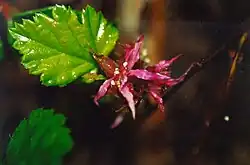Rubus nivalis
| Rubus nivalis | |
|---|---|

| |
| Scientific classification | |
| Kingdom: | Plantae |
| Clade: | Tracheophytes |
| Clade: | Angiosperms |
| Clade: | Eudicots |
| Clade: | Rosids |
| Order: | Rosales |
| Family: | Rosaceae |
| Genus: | Rubus |
| Subgenus: | Rubus subg. Chamaebatus |
| Species: | R. nivalis
|
| Binomial name | |
| Rubus nivalis | |
| Synonyms[1] | |
| |
Rubus nivalis, commonly known as snow raspberry, is a species of flowering plant in the rose family.[2] It is native to northwestern North America.
Description
Rubus nivalis is a small, prickly shrub up to 15 centimetres (6 in) tall, with stems creeping along the ground. The leaves are evergreen, 6.5 cm (2+1⁄2 in) long,[3] either simple or with three lobes, rarely divided into three leaflets.[3]
Blooming from June to September, the flowers are pink or magenta, with five petals. The fruit is a red berry with 3–10 drupelets.[4]
Distribution and habitat
It is native to British Columbia, Washington, Idaho, Oregon, and far northern California.[5][6] It grows in shaded forests and moist soil.[4]
Uses
The berry is edible.[3]
References
- ^ The Plant List, Rubus nivalis Douglas ex Hook.
- ^ Pojar, Jim; Andy MacKinnon (1994). Plants of the Pacific Northwest. Lone Pine Publishing. p. 79. ISBN 1-55105-042-0.
- ^ a b c Turner, Mark; Kuhlmann, Ellen (2014). Trees & Shrubs of the Pacific Northwest (1st ed.). Portland, OR: Timber Press. p. 257. ISBN 978-1-60469-263-1.
- ^ a b "Rubus nivalis in Flora of North America". efloras.org.
- ^ "Biota of North America Program 2014 county distribution map".
- ^ Calflora taxon report, University of California, Rubus nivalis Douglas, Snow bramble, snow dwarf bramble, snow raspberry
External links
 Media related to Rubus nivalis at Wikimedia Commons
Media related to Rubus nivalis at Wikimedia Commons- Rubus nivalis in the CalPhotos photo database, University of California, Berkeley
- "Rubus nivalis". Calflora. Berkeley, California: The Calflora Database.
- Jepson manual Treatment
- University of Washington, Burke Museum